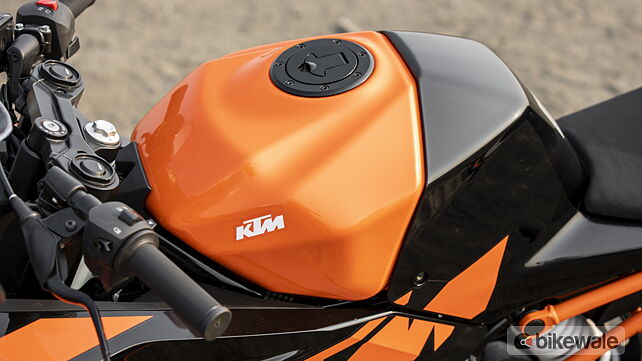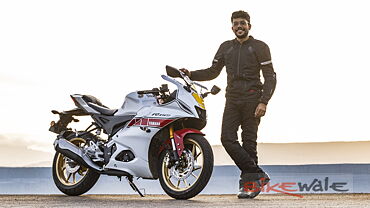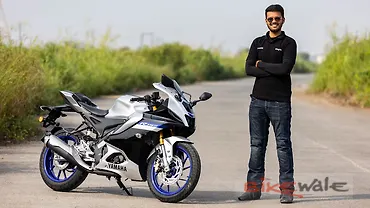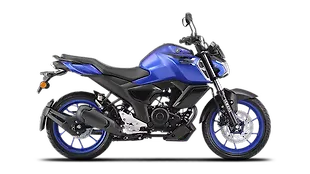Introduction

Riding motorcycles generally evokes a feeling of thrill, fun, and excitement. And when the motorcycle you ride has a full-fairing, a clip-on handlebar, and a sporty riding position, all these sentiments are escalated to a whole different level. We have two such fully-faired motorcycles with us which are hugely popular in India, not only for their sporty character but also for their accessibility. Say hello to the new KTM RC 200 and the Yamaha YZF R15 version 4.
Both these motorcycles received a major update around three months back. If you remember, we rode them both for a short duration, and individually they were quite impressive. But now we will be riding them back-to-back, to find which one makes more sense for you. Should you be spending around Rs 1.83 lakh on the R15, or put in Rs 26,000 more and go for the bigger RC 200?
Looks & Styling

With the latest update, the RC 200 and the R15 received major cosmetic makeovers, and both undoubtedly look attractive. The RC 200, with its design inspired by KTM’s MotoGP machine, looks properly radical. It also looks bigger and more modern than its predecessor. On the other hand, the R15’s styling is quite similar to its bigger sibling, the YZF R7, and the inspiration is pretty evident in its mean-looking front fascia. While the RC 200 is available only in two colour options, Yamaha offers as many as five colour variants for the R15. The one you see here is the Racing Blue trim which is more expensive than metallic red and dark knight colour options.
Ergonomics & Quality

Both these bikes surely look racy and fast. But the RC, in particular, looks bigger and even feels bigger while riding. However, if you look closely, the body panels of the RC are quite busy and there are a lot of hollow spaces in several areas. Don’t get me wrong, this is a much better build motorcycle as compared to its predecessor, but a detailed inspection revealed an uneven panel gap around the tank area and a loose panel on one side of the tail section. As for the R15, this is a more compact motorcycle and the body panels are packed more tightly. Even the paint finish and the sturdiness of plastic panels throughout are slightly better than the RC 200 in the sense that they exude a more premium vibe.

Typical of sportbikes, the RC 200 and R15 demand a committed and crouched riding position. However, there are certain differences. Getting on to the RC 200 is a little difficult because of the higher 824mm seat height. But once you’re settled in, the seat feels spacious, and the handlebar is now easier to reach as compared to the previous model of the RC. It’s also slightly higher-set as compared to the R15. One notable improvement is the design and cushioning of the seat, which are much better than before. Hence, the RC 200 should be relatively comfier to ride over longer distances.

Moving on to the R15, the seat height here is 9mm lower than the RC, so getting on the saddle is slightly easier than on the RC. But once you’re seated, the R15 feels a tad more committed as compared to the RC because of the lower-set clip-on handlebar. As a result, you have more weight on your wrist and that makes moving the bike in traffic or pushing it in the parking lot a little cumbersome. However, the lower seat helps here because you get a firmer footing on the ground and that helps in moving the bike.

The story is similar in terms of pillion comfort. Hopping on the pillion seat of the RC is quite a task. Due to its extremely high placement, the process of hopping on feels like climbing a tree. However, the presence of large and sturdy grab rails makes sure you feel secure. Even the space and design of the pillion seat is better than before.

As for the R15, it’s more welcoming for the pillion rider because, obviously, lower seat height. But then you might be left searching for something to grab on to. You can either wrap your fingers around the scoops in the tail section or crouch ahead and rest your hands on the fuel tank. Meanwhile, the padding and space isn’t something to complain about.
Features & Technology

In terms of features, the R15 is truly exceptional. The fully-digital instrument cluster not only shows more data than the RC, but it also comes with Bluetooth connectivity. Once paired with the smartphone, it gives call, SMS and email alerts. The most surprising bit is the presence of traction control and quick shifter which used to be available only in much bigger bikes. While the former isn’t really required on such a small bike, the latter is a delight to use while riding spiritedly. The whole experience is further improved by the presence of an assist and slipper clutch.

Even the RC 200 comes equipped with a fully-digital console which is larger and much easier to view as compared to the R15. However, it doesn’t show as much data as its contender and misses out on Bluetooth connectivity. Although traction control and quick shifter might be superfluous here, KTM should have offered a slipper clutch at least.
Engine & Gearbox

Nestling under their fairings are two very different powerplants, in terms of specs as well as character. The R15 continues to be powered by a 155cc, liquid-cooled engine accompanied by variable valve actuation, a system that aids in delivering useable torque spread across the rev range. The power and torque figures, at 18.1bhp and 14.2Nm, are largely the same as the previous model. As for the RC, it houses a 199.5cc, liquid-cooled engine that makes 25.4bhp and 19.5Nm. While the performance numbers haven’t changed, KTM has equipped the new RC with a bigger airbox for the engine to breathe more freely now. Even the radiator design is curved for better heat dissipation. A six-speed gearbox remains a commonality in both cases.
Performance

The advantage of larger displacement is evident from the word go. The RC is quicker off the line, it’s peppier in the city, and more potent on the highway. Even while riding it at 100kmph on open roads, flying past other vehicles is easy. As for the R15, it isn’t slow by any stretch for a 155cc bike, but it definitely feels sluggish as compared to the RC, especially in the lower end of the rev band. But once it crosses the 5,000rpm mark, the build-up of momentum is quick and enthusiastic until its redline.

Both these engines have their distinctive characters. The RC 200 is more eager and quick almost across the rev range. Plus, it feels smoother and more tractable than its predecessor. However, when compared to the R15, the overall experience is quite crude and raw. The R15 is substantially more refined and calmer than the RC 200. Even on the highway, if you’re at 100-110kmph, the footpegs and handlebar of the RC vibrate significantly. Meanwhile, the R15 has no hint of vibrations at the same speeds. There’s minor buzzing on the handlebar but it doesn’t cause any discomfort.

The gearbox of the R15 has a similar smoothness to it. The shifts are effortless and the presence of an assist and slipper clutch only adds to the convenience. The clutch can be operated even with two fingers without much effort. Although the RC’s gearbox isn’t bothersome either, the clutch isn’t as light and the gears throw tantrums at times by refusing to shift.
The brakes of both bikes are sharp and there’s ample bite on the front. But the R15 delivers more linear feedback throughout the lever action under hard braking, unlike the RC that requires a harder squeeze of the lever.
Handling & Ride Quality

An upmarket hardware package is common here. There are upside-down forks, a monoshock, and a disc brake at both ends. However, the rear spring in the RC 200 is preload adjustable which isn’t the case with the R15. Also, KTM’s disc brakes are larger in diameter. Well, the most significant change lies in their chassis – the R15 is underpinned by a Delta box frame and the RC 200 is based on a steel trellis chassis which has been revised with the recent update.

The overall package makes both bikes pretty fun to ride but in different ways. The RC 200 feels more predictable and composed while changing quick directions. It responds to your inputs with a certain maturity and grace. Whereas, the R15 feels is more nimble and vigorous. It is quicker to squeeze in through gaps in traffic. However, when riding around twisties and ghats, the R15 might scare a novice with its profound agility while the RC 200 is a little more reassuring.
As for the ride quality, the RC 200 delivers surprisingly better damping, soaking up minor undulations with extreme plushness. Even the taller bumps or high-amplitude undulations are soaked up at controlled speeds. In comparison, the R15’s rear suspension feels a bit jarring and tends to throw you off the seat, if you don’t slow down enough over bumps.
Fuel Efficiency

Despite the impressive performance, Yamaha’s smart engineering has resulted in R15’s engine being frugal. We managed to extract a fuel efficiency of 51.4kmpl, resulting in a range of about 550km with its 11-litre fuel tank. The RC 200, meanwhile, isn’t bad either. It returned a mileage of 43.5kmpl, regardless of its higher-revving nature. As a result, you get a range of around 590km from its bigger 13.7-litre gas tank.
Price & Warranty

The prices of the R15 start at Rs 1.72 lakh and go up to Rs 1.83 lakh, depending on the variant. Whereas, the RC 200 is considerably more expensive at Rs 2.09 lakh (all prices are ex-showroom). While the standard periodic warranty of both bikes is two years, Yamaha covers 40,000km as opposed to 30,000km covered by KTM.
Desirability

You see, choosing a winner amongst these two motorcycles is not an easy task at all. While the RC accelerates better, the R15 is smoother and more refined. The R15 feels more agile but the RC 200 is more predictable. The ergonomics of the RC 200 are more comfortable while getting on and off and tiptoeing is easier on the R15.
Phew …
What sets them far apart is the overall build quality, NVH levels, list of features, and pricing. In terms of technology and refinement, the R15 clearly outperforms the KTM by a substantial margin. And then, the top-spec variant of the R15 (with quick shifter as standard) is around Rs 26,000 cheaper than the RC 200.
Verdict

After spending a lot of time with both bikes, we feel the R15 comes across as a more wholesome package. If you’re a rider who’s upgrading from a smaller displacement motorcycle and want an entry-level sportbike, the R15 feels more premium and desirable. It should be a more sensible everyday motorcycle while being your companion on short weekend rides or occasional track days and tours. The RC 200, too, can perform these duties, and in a much better way than its predecessor, but in a more raw and unrefined manner than the R15. It is suitable for those who prioritise better engine performance above most other aspects.
Photography by Kaustubh Gandhi

Final Scores

Gallery
1/14
Yamaha YZF R15 V4 Open Fuel Lid
Double Tap to Zoom

















































![KTM 390 Adventure X [2025] KTM 390 Adventure X [2025]](https://imgd.aeplcdn.com/272x153/n/cw/ec/190885/390-adventure-x-2025-right-side-view.jpeg?isig=0&q=80)